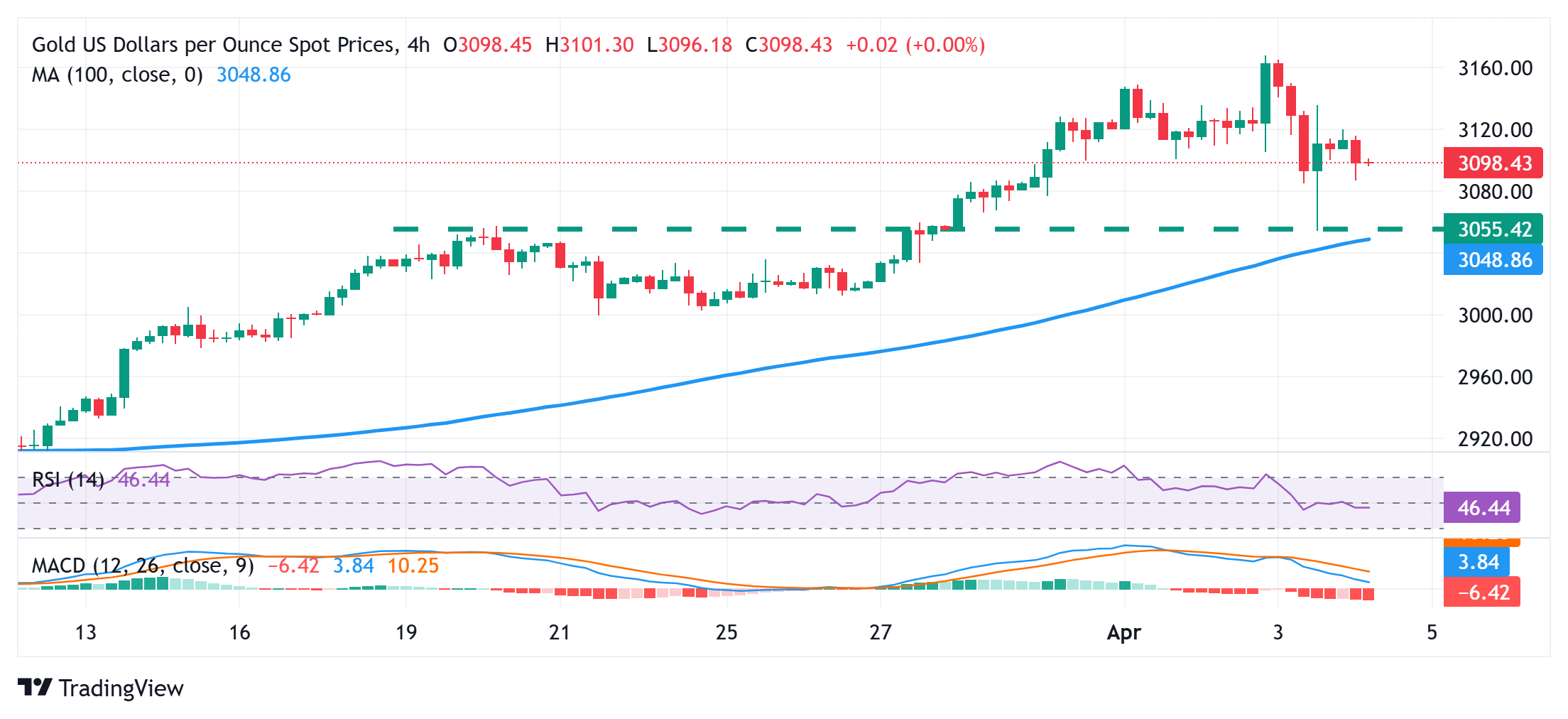- Gold price meets with a fresh supply on Friday, though the downside potential seems limited.
- Trump’s tariffs-inspired risk-off mood might continue to act as a tailwind for the precious metal.
- Fed rate cut bets weigh on the USD and also contribute to limiting losses for the XAU/USD pair.
Gold price (XAU/USD) trades with a negative bias for the second straight day on Friday, though it lacks follow-through selling and trades around the $3,100 mark heading into the European session. As investors digest US President Donald Trump’s new tariffs, traders now seem reluctant to place fresh bullish bets around the precious metal and opt to wait for the release of the US Nonfarm Payrolls (NFP) report. This, along with a modest intraday US Dollar (USD) bounce, turn out to be a key factor exerting some pressure on the commodity.
Meanwhile, investors remain worried that Trump’s sweeping reciprocal tariffs could dent global economic growth and trigger a US recession. This might force the Federal Reserve (Fed) to resume its rate-cutting cycle soon and continue to drag the US Treasury bond yields, which should cap any meaningful USD recovery and act as a tailwind for the non-yielding Gold price. Hence, it will be prudent to wait for strong follow-through selling before confirming that the XAU/USD has topped out and positioning for a deeper corrective fall.
Daily Digest Market Movers: Gold price bulls remain on the sidelines ahead of US NFP; downside seems cushioned
- Gold price attracts some sellers for the second successive day on Friday, though a combination of factors should continue to act as a tailwind and limit any meaningful corrective slide from the record high.
- US President Donald Trump rattled global financial markets late Wednesday and unveiled reciprocal tariffs of at least 10% on all imported goods, which could negatively impact the world economy.
- Traders ramped up expectations that the Federal Reserve will resume its rate-cutting cycle in June and lower borrowing costs four times by the year-end as Trump’s trade policies reignite US recession fears.
- The yield in the benchmark 10-year US government bond slides below 4.0% for the first time in six months and fails to assist the US Dollar to build on the overnight bounce from a multi-month trough.
- Meanwhile, data released on Thursday showed that economic activity in the US services sector eased momentum in March, with the ISM Services PMI falling to 50.8 from 53.5 in February and missing estimates.
- Separately, the US Department of Labor (DOL) reported US citizens filing new applications for unemployment insurance ticked lower to 219K for the week ending March 29 from the 225K previous.
- The aforementioned fundamental backdrop favors the XAU/USD bulls. Hence, the modest downtick could be attributed to some repositioning trade ahead of the release of the monthly US employment details.
- The popularly known US Nonfarm Payrolls (NFP) report is expected to show that the US economy added 135K new jobs in March, though the Unemployment Rate is anticipated to hold steady at 4.1%.
Gold price might continue to attract dip-buyers; $3,056-3,054 pivotal support holds the key for bullish traders

From a technical perspective, any subsequent fall might continue to find decent support near the $2,056-2,054 horizontal zone. The said area nears the 100-period Simple Moving Average (SMA) on the 4-hour chart and should now act as a key pivotal point for short-term traders. A convincing break below might prompt some technical selling and make the Gold price vulnerable to accelerate the corrective slide further towards the $3,036-3,035 intermediate support en route to the $3,000 psychological mark,
On the flip side, the $3,115-3,125 congestion zone now seems to act as an immediate hurdle. This is followed by resistance near the $3,143 area and the all-time peak, around the $3,157-3,158 region touched on Thursday, which if cleared could be seen as a fresh trigger for bullish traders. This, in turn, will set the stage for an extension of the Gold price’s recent well-established uptrend witnessed over the past four months or so.
Fed FAQs
Monetary policy in the US is shaped by the Federal Reserve (Fed). The Fed has two mandates: to achieve price stability and foster full employment. Its primary tool to achieve these goals is by adjusting interest rates.
When prices are rising too quickly and inflation is above the Fed’s 2% target, it raises interest rates, increasing borrowing costs throughout the economy. This results in a stronger US Dollar (USD) as it makes the US a more attractive place for international investors to park their money.
When inflation falls below 2% or the Unemployment Rate is too high, the Fed may lower interest rates to encourage borrowing, which weighs on the Greenback.
The Federal Reserve (Fed) holds eight policy meetings a year, where the Federal Open Market Committee (FOMC) assesses economic conditions and makes monetary policy decisions.
The FOMC is attended by twelve Fed officials – the seven members of the Board of Governors, the president of the Federal Reserve Bank of New York, and four of the remaining eleven regional Reserve Bank presidents, who serve one-year terms on a rotating basis.
In extreme situations, the Federal Reserve may resort to a policy named Quantitative Easing (QE). QE is the process by which the Fed substantially increases the flow of credit in a stuck financial system.
It is a non-standard policy measure used during crises or when inflation is extremely low. It was the Fed’s weapon of choice during the Great Financial Crisis in 2008. It involves the Fed printing more Dollars and using them to buy high grade bonds from financial institutions. QE usually weakens the US Dollar.
Quantitative tightening (QT) is the reverse process of QE, whereby the Federal Reserve stops buying bonds from financial institutions and does not reinvest the principal from the bonds it holds maturing, to purchase new bonds. It is usually positive for the value of the US Dollar.

